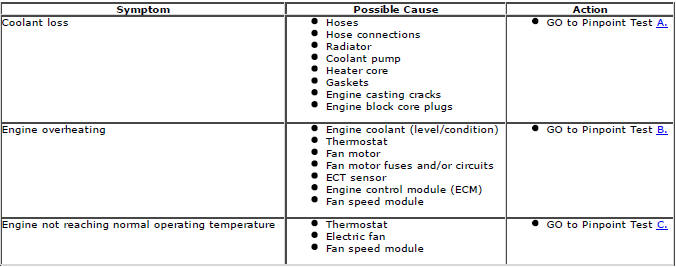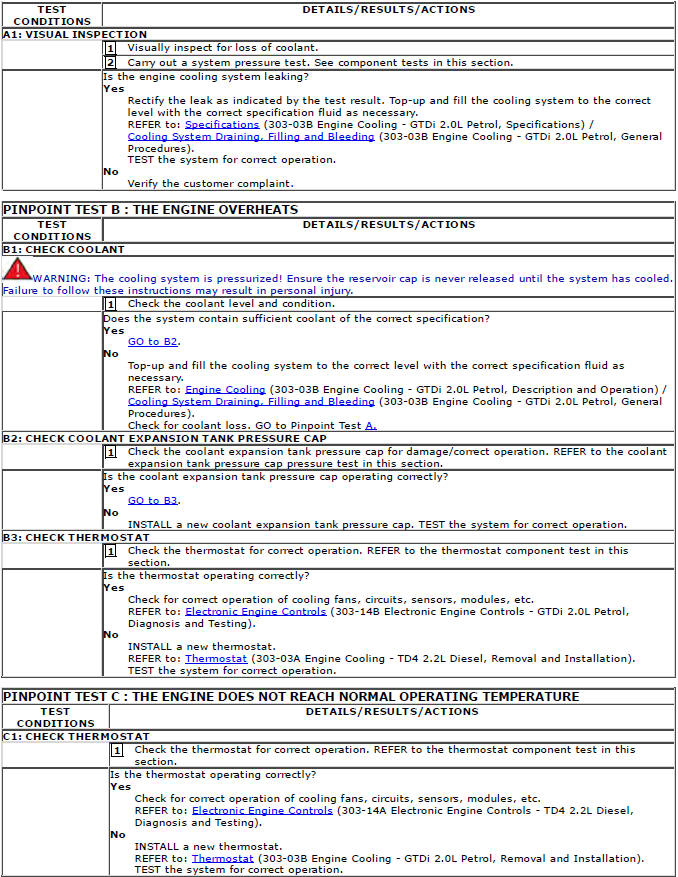Range Rover Evoque: Engine Cooling - Diagnosis and Testing
Principles of Operation
For a detailed description of the cooling system, refer to the relevant Description and Operation section in the workshop manual. REFER to: (303-03B Engine Cooling - GTDi 2.0L Petrol)
Inspection and Verification
CAUTION: Diagnosis by substitution from a donor vehicle is NOT acceptable. Substitution of control modules does not guarantee confirmation of a fault, and may also cause additional faults in the vehicle being tested and/or the donor vehicle.
1. Verify the customer concern.
2. Visually inspect for obvious signs of mechanical or electrical damage.
Visual Inspection

3. If an obvious cause for an observed or reported concern is found, correct the cause (if possible) before proceeding to the next step
4. If the cause is not visually evident, verify the symptom and refer to the Symptom Chart, alternatively, check for Diagnostic Trouble Codes (DTCs) and refer to the DTC Index.
Symptom Chart

DTC Index
For a complete list of all Diagnostic Trouble Codes (DTCs) that could be logged on this vehicle, please refer to Section 100-00. REFER to:
Diagnostic Trouble Code (DTC) Index - GTDi 2.0L Petrol, DTC: Engine Control
Module (PCM), B1087-93 to P0200-81
(100-00, Description and Operation),
Diagnostic Trouble Code (DTC) Index - GTDi 2.0L Petrol, DTC: Engine Control
Module (PCM), P0201-13 to P0480-13
(100-00, Description and Operation),
Diagnostic Trouble Code (DTC) Index - GTDi 2.0L Petrol, DTC: Engine Control
Module (PCM), P0496-00 to P2138-00
(100-00, Description and Operation),
Diagnostic Trouble Code (DTC) Index - GTDi 2.0L Petrol, DTC: Engine Control
Module (ECM) (100-00 General
Information, Description and Operation).
Pinpoint Tests


Component Tests
Cooling System Pressure Test
WARNING: Never, under any circumstances, remove the coolant expansion tank pressure cap while the engine is operating. To avoid having scalding hot water or steam blow out of the cooling system, use extreme care when removing the coolant expansion tank pressure cap from a hot cooling system. Wait until the engine has cooled, then wrap a thick cloth around the coolant expansion tank pressure cap and turn it slowly until the pressure begins to release, step back while the pressure is released from the system. When certain all the pressure has been released (still with a cloth) turn and remove the coolant expansion tank pressure cap. Failure to follow these instructions may result in damage to the cooling system, engine and/or cause personal injury.
1. Switch the engine off.
2. Open the hood and install protective fender covers.
3. Carefully remove the coolant expansion tank pressure cap from the coolant expansion tank to relieve pressure in the cooling system. Add coolant to coolant expansion tank as necessary.
4. Install the pressure tester equipment to the cooling system following manufacturers instructions. Reinstall the coolant expansion tank pressure cap (if pressure test equipment is not installed to the coolant expansion tank).
5. Pressurize the cooling system to the coolant expansion tank pressure cap lower limit.
6. Observe the gauge reading for approximately two minutes. Pressure should not drop during this time.
- If system holds pressure, continue from step 7.
- If the pressure drops, check the complete cooling system for leaks. Also refer to engine system checks if a leak cannot be located in the cooling system. Correct any leaks found and recheck the system.
7. Release the system pressure and remove the pressure test equipment. Check the coolant level. Replenish as necessary with the correct coolant solution.
REFER to: Specifications (303-03B Engine Cooling - GTDi 2.0L Petrol, Specifications).
8. Check the radiator overflow hose for any obstructions which may block the flow of coolant either to or from the coolant expansion tank.
9. Conduct the coolant expansion tank pressure cap pressure test in this section.
Coolant Expansion Tank Pressure Cap Pressure Test
WARNING: Never, under any circumstances, remove the coolant expansion tank pressure cap while the engine is operating. To avoid having scalding hot water or steam blow out of the cooling system, use extreme care when removing the coolant expansion tank pressure cap from a hot cooling system. Wait until the engine has cooled, then wrap a thick cloth around the coolant expansion tank pressure cap and turn it slowly until the pressure begins to release, step back while the pressure is released from the system. When certain all the pressure has been released (still with a cloth) turn and remove the coolant expansion tank pressure cap. Failure to follow these instructions may result in damage to the cooling system, engine and/or cause personal injury.
1. Remove the expansion tank pressure cap from the coolant expansion tank.
2. Use water to clean cap in area of rubber seal and vacuum relief valve. Following manufacturers instructions, install the coolant expansion tank pressure cap to the pressure tester.
3. NOTE: If the pressure tester is pressurised too quickly, an erroneous pressure reading may result. Slowly pressurise the system until the pressure gauge reading stops increasing, and note highest pressure reading obtained.
4. Release pressure and repeat Step 3 at least twice to make sure the pressure test reading is repeatable and within specification.
5. If the pressure test gauge readings are not within specification, install a new coolant expansion tank pressure cap.
Thermostat Test
Remove the thermostat
REFER to: Thermostat (303-03B Engine Cooling - GTDi 2.0L Petrol, Removal and Installation).
Inspect for visible damage, note its opening temperature and immerse it in water. Heat the water until this temperature is reached. The thermostat should begin to open. If it does not begin to open, install a new thermostat.
REFER to: Thermostat (303-03B Engine Cooling - GTDi 2.0L Petrol, Removal and Installation).
If thermostat begins to open, continue to heat the water until the thermostat fully opens, 5.8 mm (0.2 in) or more off the seat. If it does not fully open, install a new thermostat.
REFER to: Thermostat (303-03B Engine Cooling - GTDi 2.0L Petrol, Removal and Installation).
Radiator Leak Test - Removed from the Vehicle
CAUTION: Do not leak test an aluminium radiator in the same water that is used to leak test copper/brass radiators.
Flux and caustic cleaners may be present in the test water which will corrode aluminium. If a separate tank is not available, drain and rinse the test tank before testing an aluminium radiator.
Clean the radiator before leak testing to prevent contamination of the test tank. Leak test the radiator in clean water with 138 kPa (20 psi) air pressure.

